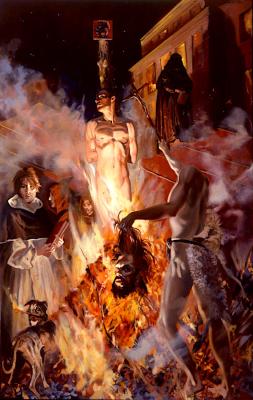Paintings by André Durand
Born in Ottawa, Ontario in 1947, André Durand is a Canadian photographer and painter of Irish ancestry who works within the European Hermetic tradition. At the age of seventeen, he left Canada with his wife Ludmilla to emigrate to Europe. Through its history, Hermeticism was closely associated  with the idea of a primeval, divine wisdom that was revealed to ancient sages. Hermeticism remains influential within esoteric Christianity, particularly in the Christian mystical tradition of Maartinism. The anonymously written 1967 French tome “Meditations on the Tarot”, later edited and published by Robert Powell in 1980, summarizes the theory and practices of Christian Hermeticism.
with the idea of a primeval, divine wisdom that was revealed to ancient sages. Hermeticism remains influential within esoteric Christianity, particularly in the Christian mystical tradition of Maartinism. The anonymously written 1967 French tome “Meditations on the Tarot”, later edited and published by Robert Powell in 1980, summarizes the theory and practices of Christian Hermeticism.
Best known for his allegorical portraits of such figures as Princess Diane, Durand’s mythologically inspired paintings are the foundation of his work. These pieces display his deep understanding of the rituals and myths of both Christian and  Classical traditions. Influenced by Michelangelo, Rubens and Titian, Durand tries to unite his religion with his art; however, he approaches the subject with the objective and philosophical criteria of a Neo-modernist.
Classical traditions. Influenced by Michelangelo, Rubens and Titian, Durand tries to unite his religion with his art; however, he approaches the subject with the objective and philosophical criteria of a Neo-modernist.
In 1970 André Durand painted a series of images inspired by the dancers of the British Royal Ballet. His 1972 portrait of Irish novelist Elizabeth Bowen, whose work often bears heavily on the psychology of its characters, is housed in London’s National Portrait Gallery. Durand has also received international acclaim for his official portraits of Pope John Paul II and the fourteenth Dalai Lama.
In 2000, Durand became artist in residence at London’s Kingston Upon Thames University. A major exhibition in 2006, entitled “Durand Wholly Pictures” and which covered six years of work, was displayed in churches and cathedrals in the county of Sussex. These works depicted devotional Christian narratives set in traditional Sussex landscapes.  In November of 2007, André Durand produced his oil on linen “Daniel in the Lions’ Den”; the sale of the painting and its limited edition prints benefited the Demelza Hospice Care for Children, a charity in Kent that provides support to life-limited children and their families.
In November of 2007, André Durand produced his oil on linen “Daniel in the Lions’ Den”; the sale of the painting and its limited edition prints benefited the Demelza Hospice Care for Children, a charity in Kent that provides support to life-limited children and their families.
After his return to Italy, André Durand visited the commune of Torre del Greco in Naples and the coastal town of Sperlonga, known for its sculptures and Roman sea grotto at the Villa of Tiberius. At the invitation of the Museo Archeologico Nazionale di Sperlonga, he opened a studio at the museum as artist in residence for two years. From 2010 to 2012, Durand began a series of round formal paintings on the subject of the Stations of the Resurrection, many of which contain the Grotto of Tiberius in the background.
Durand published several art photography volumes of his work in 2012. Most notable among them is the “Fotograf ando Statue per Anno”, an image collection of the statuary in Sperlonga’s National Archeological Museum. Containing text  co-written by the museum’s director Marisa de’Spagnolls, this volume of sculptural work is the only comprehensive photographic archive of the museum’s collection.
co-written by the museum’s director Marisa de’Spagnolls, this volume of sculptural work is the only comprehensive photographic archive of the museum’s collection.
André Durand’s work has been featured in many solo exhibitions in Italy and England. These include, among others, “Frammenti Classici” in 1995 at London’s Archeus Fine Art; the 2000 “Soggetti Italianizzati” at the Galleria Albemarle in London; and “Via Lucis e Lagrime di San Pietro” at Galleria Santa Maria Maggiore in Rome. Durand’s work is in many private collections and the permanent collections of the Scottish National Gallery and London’s National Portrait Gallery. He currently lives and works in Sperlonga, Italy.
Images of André Durand’s work, a manifesto on Neo-modernism, enquiries for commissions, and contact information can be found at the artist’s site: http://andredurandportraits.com
Second Insert Image: André Durand, “Saint Christopher Cynocephalus”, 2010, “Sacred” Series, Oil on Linen, 167.5 x 112 cm
Third Insert Image: André Durand, “Narcissus”, 2001, “Mythology” Series, Oil on Linen, 61 x 48 cm, Private Collection, Rome
Bottom Insert Image: André Durand, “Giordano Bruno Burning”, 2000, “Profane” Series, Oil on Linen, 203.2 x 167.6 cm















